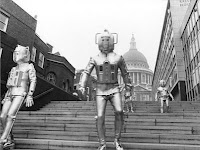Spearhead from Space
by Robert Holmes
Originally Broadcasted: January 3rd-24th, 1970
The Doctor has just regenerated and collapsed outside his TARDIS into an open field. Brigadier Lethbridge-Stewart manages to find the Doctor, although he's not too certain if he's got the right man. Meanwhile, some mysterious going-ons are happening at a plastics factory, "meteorites have fallen to Earth," and a strange looking plastic man is out to collect the "meteorites"...
At the end of Patrick Troughton's swan-song,
The War Games, the Doctor was banished to Earth and sent into a forced regeneration for his interference in the affairs of others. And that's where
Spearhead from Space picks up. This story ushered in a whole new era of Doctor Who, much like
The Leisure Hive would do 10 years later. For the first time, the show was in color. Each episode from this season is based on Earth, and of course, Jon Pertwee is now the Doctor. From the get-go, he is most definitely the Doctor, but very different at the same time. He starts off with a little childishness left over from his predecessor, but I think that was just some regeneration woes. Once the Doctor is up on his feet, he becomes the charming, suave, and dashing Doctor that only Jon Pertwee could pull off. Pertwee doesn't get too much to work with here, so it's not his most memorable story from an actor's standpoint, but he still does put a fine, firm mark on the role. After getting a test run in the previous season, UNIT comes into the show in full form for
Spearhead in Space, although at this point we just have Brigadier Lethbridge-Stewart (Sgt. Benton would pop back up in
The Ambassadors of Death). The relationship between the Brig and the Doc is a bit more tense in the early Pertwee stories, not the warm UNIT family we see in later years. In trying to make a more well-rounded character for a companion, this story introduces Liz Shaw, a scientist for UNIT. Although it seems that Liz and her characterization were not that popular, as in the next story (
Doctor Who and the Silurians) it's back to short skirts and screaming before Liz Shaw gets the unceremonious boot at the end of the season. Writer of the story, Robert Holmes, introduces a marvelous Doctor Who alien in
Spearhead from Space, the Autons, servants of the Nestene Consciousness. The Nestene can control any form of plastic, including shop window dummies, making for one of the most iconic and terrifying scenes in the history of Doctor Who. That's what Doctor Who does great: It takes something well known like a shop window dummy and puts evil life into it. What a great idea Holmes stumbled upon. It worked so well that the Autons returned for a sequel the following year, and have been used a few times in new Who too. This story is unique for being the only story in the history of Doctor Who to be filmed entirely on film. Yes, even the interior scenes.
Spearhead from Space was an almost perfect introduction into a brand new era of Doctor Who. Yes, things are all set on Earth now, but that doesn't mean the quality of the show should decrease. Robert Holmes proved that with one of his best stories, and Jon Pertwee proved that by instantly making the Doctor is own. Thumbs up from me!
Luke's Rating:
8/10












































